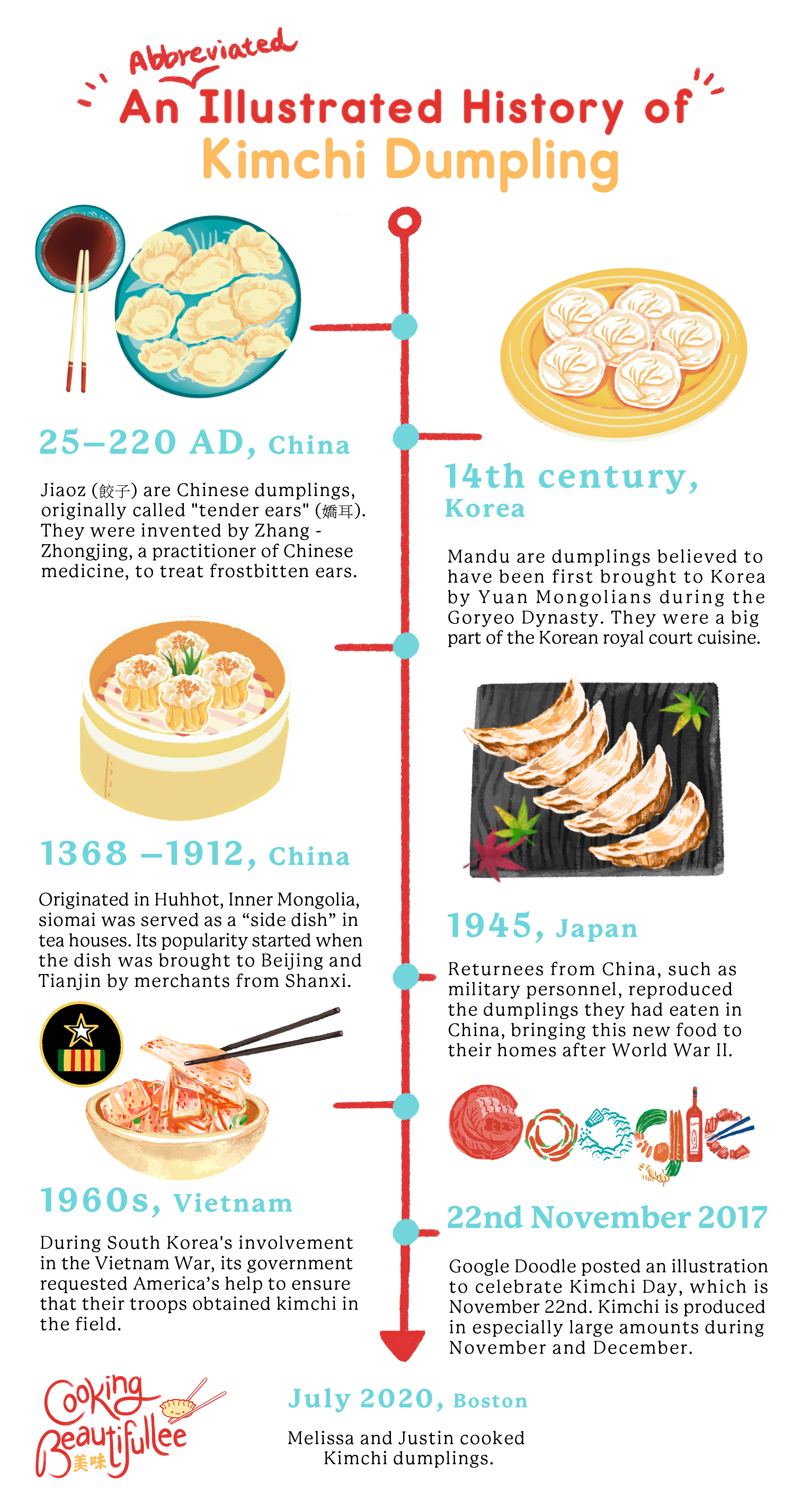Under the Sea Kimchi Dumplings
Growing up in Taiwan, I had heard the word “kimchi” since I was little, but I had never seen it in real life until I was in college. My dad sent me to Columbia University to study English (ESL: English as a Second Language) during summer vacation. One of my roommates was Korean. One day, he was preparing a burger for lunch, and I wouldn’t take my eyes off of him. Not because he was handsome, but because I was intrigued by the “red looking vegetable” on his patty. “What did you put on your patty?” I couldn’t help asking.
“Kimchi!” he answered.
“Wow! You eat kimchi with a burger?” I was a little bit surprised. For some reason, I associated kimchi as a banchan and enjoyed with rice.
“No, I pair almost everything I eat with kimchi. It works well that way!”
Salty, spicy, and wonderfully funky, a jar of kimchi can keep in your fridge for a long time. Kimchi all the way! You can use it to make kimchi pancakes, kimchi fried rice, kimchi stew, kimchi pasta, kimchi burger, and kimchi dumplings. The first time I ate kimchi dumplings was in Din Tai Fung (鼎泰豐), a world-renowned Taiwanese restaurant that specializes in soup dumplings and noodles. Those dumplings were juicy, pungent, and super savory.
I couldn’t stop thinking about those dumplings, so I decided to create this dish with Justin. I am the dough master since my formal culinary training has been on the pastry side. Justin is in charge of the fillings since he has years of experience cooking seafood in commercial kitchens. In Taiwan and China, most dumpling fillings are made of pork. Shrimp are popular for dumplings called wontons (雲吞). 雲吞 means “swallowing clouds” in Chinese. This kind of dumplings should be soft, slippery, and light—like you are swallowing clouds in your mouth. Both Justin and I love the light texture of scallops—light in texture, bold in flavor—so that’s what we used in our kimchi.
So, here we are! Under the sea Kimchi dumplings. We hope you will like them!

Under The Sea Kimchi Dumplings
Equipment
- Chef’s knife
- Cutting board
- Measuring cups and spoons
- Medium bowl
- Rubber spatula
- Plate
- Paper towels
- Chinese small rolling pins
- Chopsticks
- Food processor
Ingredients
Basic Dough (makes one pound)
- Makes 1 pound
- 10 ounces 2 cups unbleached all-purpose flour
- About ¾ cup just boiled water
Fillings
- ¼ lb Small sea scallops
- ½ lb Shrimp peeled and deveined
- 1 teaspoon Salt
- ½ teaspoon Sugar
- 1/8 teaspoon ground white pepper
- 1 each 1” piece Ginger grated
- 1 each Garlic clove grated
- 2 tablespoon Light soy sauce
- 1 teaspoon Rice wine vinegar
- 1 teaspoon Kimchi paste
- 3 tablespoons. Cornstarch
- ½ cup Kimchi fermented cabbage chopped fine by hand
- 1 tbsp. Sake
Dipping Sauce:
- 2 tbsp. Soy sauce
- 2 tbsp. Chinkiang or rice wine vinegar
- 1 tbsp. Finely sliced scallion greens
- 1/2 tsp. Grated fresh ginger
- 2 tsp. Sugar
Instructions
To Make the Dough
- Prepare the dough in a food processor, and put the flour in the work bowl. With the machine running, add ¾ cup of water in a steady stream through the feed tube. As soon as all the water has been added, stop the machine and check the dough. It should look rough and feel soft but firm enough to hold its shape when pinched. If necessary, add water by the teaspoon or flour by the tablespoon. When satisfied, run the machine for another 5 to 10 seconds to further knead and form a ball around the blade. Avoid overworking the dough.
- Alternatively, make the dough by hand. Put a bowl atop a kitchen towel to prevent it from slipping while you work. Put the flour in the bowl and make a well in the center. Use a wooden spoon to stir the flour while you add ¾ cup water in a steady stream. Aim to evenly moisten the flour. When all the water has been added, you will have lots of lumpy bits. Knead the dough in the bowl to bring all the lumps into one mass. If the dough does not come together easily, add water by the teaspoon.
- Transfer the dough and any bits to the work surface. Flour your work surface only if necessary, and then sparingly. Knead the dough with the heel of your hand until smooth and somewhat elastic. Press on the dough; it should slowly bounce back with a light impression of your finger remaining. Cover the dough well and allow it to rest for at least 15 minutes and up to 2 hours.
- After resting, the dough can be used right away to form the wrappers.
To Make the Filling
- Take both the shrimp and the scallops and lay them out onto a plate lined with a paper towel to dry them off. Place the plate of shellfish in the freezer for 5 minutes to chill it down.
- Place the cold shellfish, salt, and sugar into the food processor. Pulse several times until a shellfish paste forms. Do not just run the processor because that will warm the mixture too much. Use a rubber spatula to scrape down the sides and pulse again a couple more times.
- Add in the grated ginger, garlic, soy sauce, vinegar, kimchi paste, and cornstarch and continue to pulse to incorporate the ingredients, scraping down the sides as necessary.
- Add in the finely chopped kimchi cabbage and pulse a couple of times to start the mixing. Take the filling out of the processor and place into a medium bowl. Using a rubber spatula fold until everything seems well incorporated.
To Make the Dumplings
- Form wrappers from the dough. Work with half the dough at a time.
- Before assembling the dumplings, line a baking sheet with parchment paper. Dust the parchment paper with cornstarch or flour.
- For each dumpling, hold a wrapper in a slightly cupped hand. Scoop up about 1 tablespoon of filling with a bamboo dumpling spatula, dinner knife, or fork and position it slightly off-center toward the upper half of the wrapper, pressing and shaping it into a flat mound and keeping about ½ to ¾ inch of wrapper clear on all sides.
- Fold, pleat, and press to enclose the filling and create half-moon, pea pod, or pleated crescent shapes. Place the finished dumplings on the prepared baking sheet. Repeat with the other wrappers, assembling the dumplings and spacing them apart so that they do not touch. Keeping the finished dumplings covered with a dry kitchen towel, form and fill the wrappers from the remaining dough.
- To pan-fry the dumplings, using a medium or large nonstick skillet; if both sizes are handy, cook two batches at the same time. Heat the skillet over medium-high heat and add 1½ tablespoons of oil for a medium skillet and 2 tablespoons for a large one. Place the dumplings one at a time, sealed edges up, in a winding circle pattern. The dumplings can touch. Fry the dumplings for 1 to 2 minutes, until they are golden or light brown on the bottom.
- Holding the lid close to the skillet, use a kettle or measuring cup to add water to a depth of roughly ¼ inch. Cover with a lid or aluminum foil, lower the heat to medium and let the water bubble away for 8 to 10 minutes until it is mostly gone. After 6 to 8 minutes, move the lid or foil so that it is slightly ajar to allow steam to shoot out from underneath. This lessens the drama of condensation dropping down onto the hot oil when you remove the lid. When most of the water is gone, remove the lid. Let the dumplings fry for another 1 to 2 minutes, until the bottoms are brown and crisp.
- Remove from heat and serve immediately. Display them with their bottoms facing up so that they remain crisp. Serve with dipping sauce.
Notes
Storage Tips
You can store the filling in the refrigerator covered for no more than 3 days or freeze in freezer bags and pull out to use when needed. Once the dumplings are all assembled, they can be covered with plastic wrap and refrigerated for several hours. They can be cooked straight from the refrigerator. For longer storage, freeze them on their baking sheet until hard, transfer to a zip-lock bag, and keep frozen for up to one month.Chef’s Tips
It is necessary to keep the mixture cold during the process, or else the finished dumpling will seem grainy. You could also make this filling with either just scallops or just shrimp, but the mix of scallops and shrimp makes for a better texture.Join Our Community at Patreon
Perks for Friends of Food Patrons only:
Friends of Food is a digital members-only community designed to empower and connect food folks alike.
- Invitation to private community & food folk directory
- Access to a highly vetted network of Chefs
- One hour Zoom cooking lesson once a month
- Cookbook club + happy hour once a month
- 30 mins cooking consultation
- E-mail us your cooking questions and we will get back to you with our best answer within a week.
- Shoutout
- Polls (Help us choose a topic for an upcoming video + more!)
- Behind-the-scenes / Bloopers
- Exclusive perks from brand partners
Here are the Amazon affiliate links for you to order the ingredients and tools to create this delicious dish.
Cutlery
Epicurean Gourmet Series Cutting Board, 17.5-Inch by 13-Inch, Natural/Slate
Miyabi 34313-213 Fusion Morimoto Edition Chef's Knife, 8-inch, Black w/Red Accent/Stainless Steel
Electrics
Breville BFP660SIL Sous Chef 12 Cup Food Processor, Silver
Hand Tools/Gadgets
Le Creuset JS410-17 Craft Series Medium Spatula, 11 1/8" x 2 1/4", Caribbean
Bamber Wood Rolling Pin, 11 Inch by 1-1/5 Inch
Kyocera Advanced Ceramic 3-1/2-inch Ceramic Grater
Food
Domino Pure Cane Organic Sugar - 24 oz
Marukan Genuine Brewed Rice Vinegar, 24 oz

Melissa Lee
Chief Entertainment Officer
Melissa is 100% MIT (Made in Taiwan), where she worked as a food writer. She’s also worked alongside renowned chefs like Ming Tsai and Joanne Chang, honing her craft and gathering stories along the way. Part story-teller, part educator, and part food lover, Melissa brings a special blend of experience, skill, and enthusiasm to her work. She blends her Asian background, her new home of New England, and love of food and culture to bring joy, optimism, and inspiration to food lovers and fun-seekers everywhere.
What sparked your passion for the industry?
The desire to make things by hand. The joy of sharing delicious, hearty food with students. The opportunity for people to get connected via cooking and baking. When a child smiled broadly and told me it’s the best scone he has ever made and eaten, it really made my day!
In your opinion, what’s the most important course?
Well, I usually take a peek at the wine list first. I like tapas style, so the course doesn’t really matter. Cheese and charcuterie are always a good place to start. And since I’m a pastry chef, there is always room for dessert!
Bill Gates is picking up your tab, where would you go?
Noma, Copenhagen.

